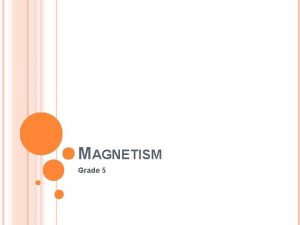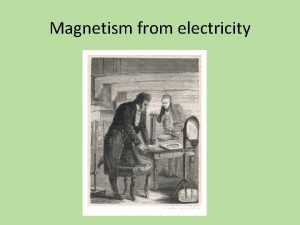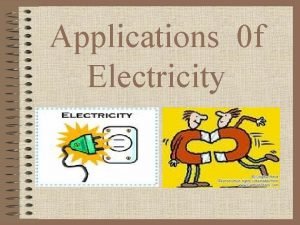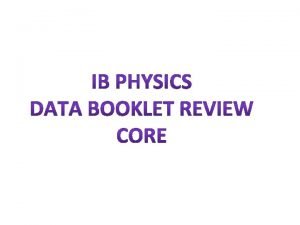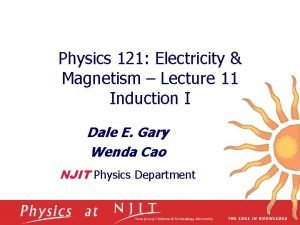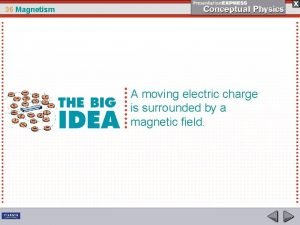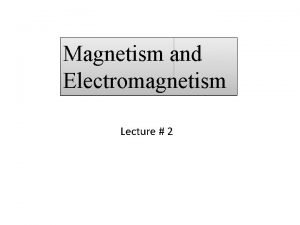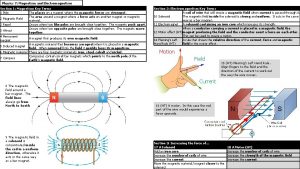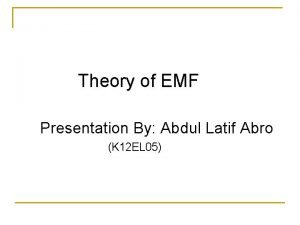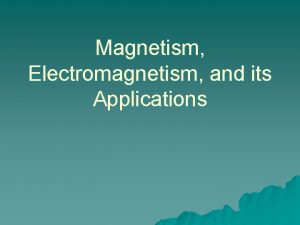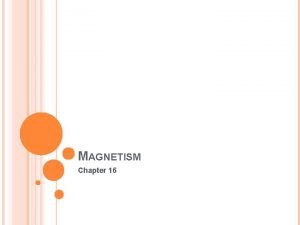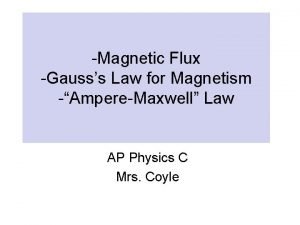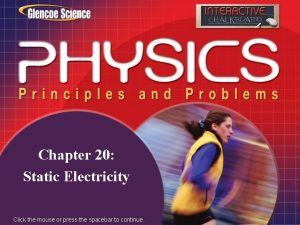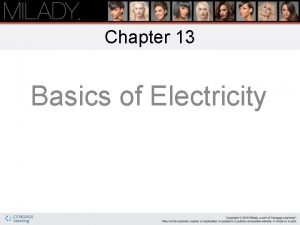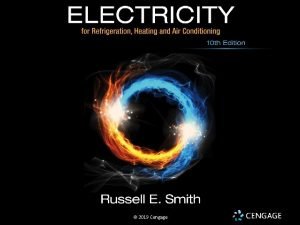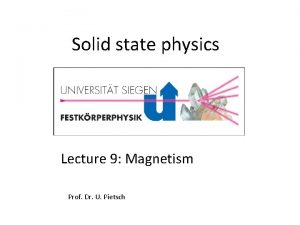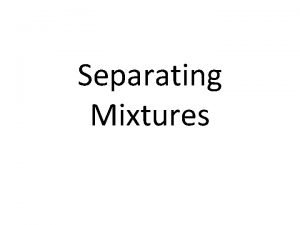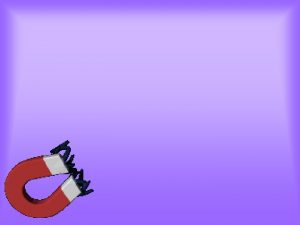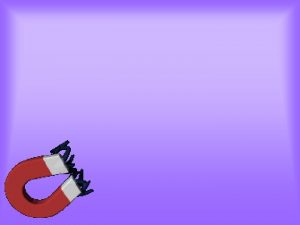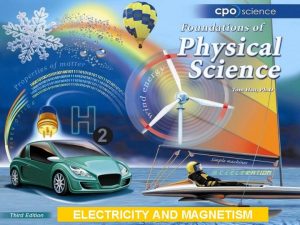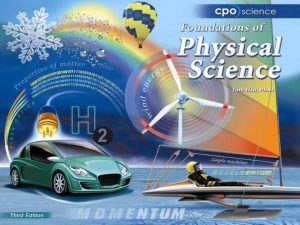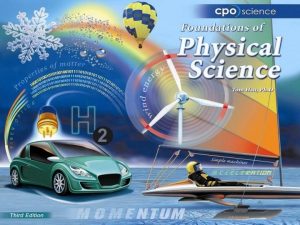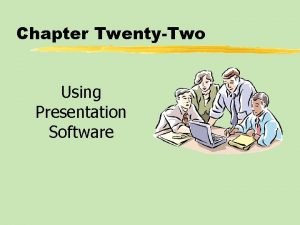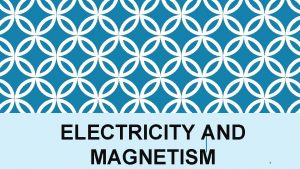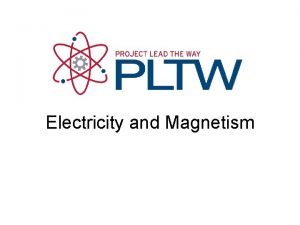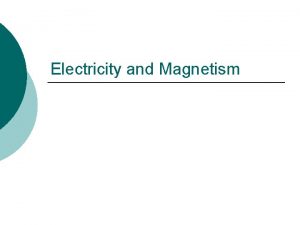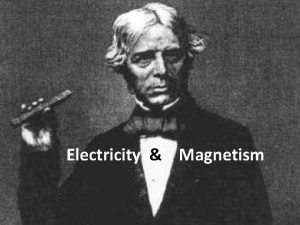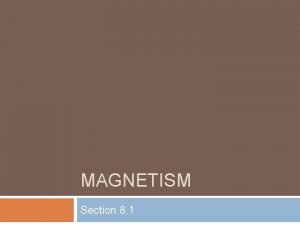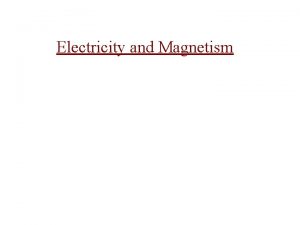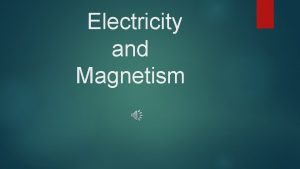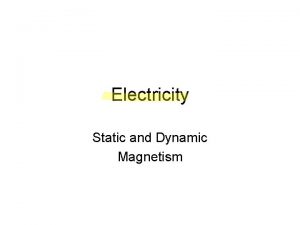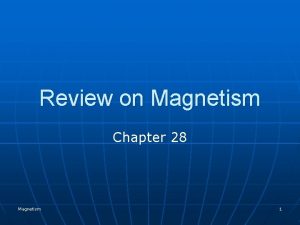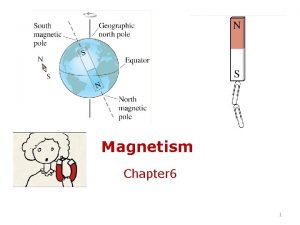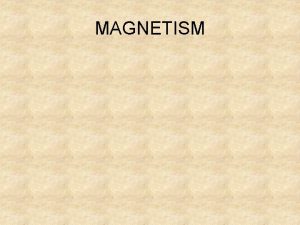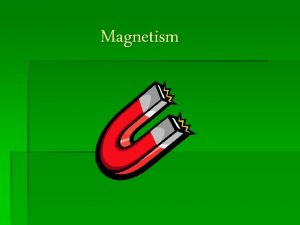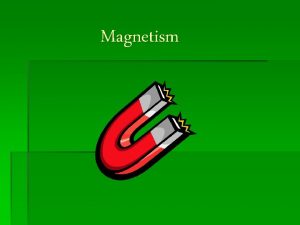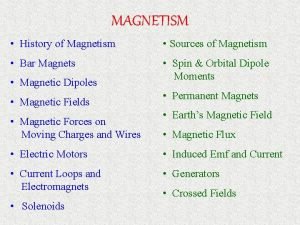Chapter TwentyTwo Electricity and Magnetism 22 1 Properties






































- Slides: 38


Chapter Twenty-Two: Electricity and Magnetism Ø 22. 1 Properties of Magnets Ø 22. 2 Electromagnets Ø 22. 3 Electric Motors

22. 1 Properties of Magnets ØIf a material is magnetic, it has the ability to exert forces on magnets or other magnetic materials nearby. ØA permanent magnet is a material that keeps its magnetic properties.

22. 1 Properties of Magnets ØAll magnets have two opposite magnetic poles, called the north pole and south pole. ØIf a magnet is cut in half, each half will have its own north and south poles.

22. 1 Properties of Magnets ØWhether the two magnets attract or repel depends on which poles face each other.

22. 1 Properties of Magnets ØMagnetic forces can pass through many materials with no apparent decrease in strength.

22. 1 Properties of Magnets ØMagnetic forces are used in many applications because they are relatively easy to create and can be very strong. ØLarge magnets create forces strong enough to lift a car or a moving train.

22. 1 Magnetic fields ØThe force from a magnet gets weaker as it gets farther away. ØSeparating a pair of magnets by twice the distance reduces the force by 8 times or more.

22. 1 Magnetic fields ØA special kind of diagram is used to map the magnetic field. ØThe force points away from the north pole and towards the south pole.

22. 1 Magnetic fields ØYou can actually see the pattern of the magnetic field lines by sprinkling magnetic iron filings on cardboard with a magnet underneath.

22. 1 Magnetic field lines ØA compass needle is a magnet that is free to spin. ØBecause the needle aligns with the local magnetic field, a compass is a great way to “see” magnetic field lines.

22. 1 Geographic and magnetic poles ØThe planet Earth has a magnetic field that comes from the core of the planet itself.

22. 1 Declination and “true north” ØBecause Earth’s geographic north pole (true north) and magnetic south pole are not located at the exact same place, a compass will not point directly to the geographic north pole. ØThe difference between the direction a compass points and the direction of true north is called magnetic declination.

22. 1 Declination and “true north” ØMagnetic declination is measured in degrees and is indicated on topographical maps.

22. 1 Declination and “true north” ØMagnetic declination is measured in degrees and is indicated on topographical maps. ØMost good compasses contain an adjustable ring with a degree scale used compensate for declination.

22. 1 Earth’s magnetism ØStudies of earthquake waves reveal that the Earth’s core is made of hot, dense molten metals. ØHuge electric currents flowing in the molten iron produce the Earth’s magnetic field.

22. 1 Earth’s magnetism ØThe gauss is a unit used to measure the strength of a magnetic field. ØThe magnetic field of Earth (. 5 G) is weak compared to the field near the ceramic magnets you have in your classroom. (300 - 1, 000 G). ØFor this reason you cannot trust a compass to point north if any other magnets are close by.

22. 1 Earth’s magnetism ØToday, Earth’s magnetic field is losing approximately 7 percent of its strength every 100 years. ØIf this trend continues, the magnetic poles will reverse sometime in the next 2, 000 years.

22. 2 Electomagnets ØElectromagnets are magnets that are created when there is electric current flowing in a wire. ØThe simplest electromagnet uses a coil of wire wrapped around some iron.

22. 2 Right hand rule ØTo find the north pole of an electromagnet, use the right hand rule. ØWhen the fingers of your right hand curl in the direction of the wire, your thumb points toward the magnet’s north pole.

22. 2 Doorbells ØA doorbell contains an electromagnet. ØWhen the button of the bell is pushed, it sends current through the electromagnet.

22. 2 Building an electromagnet ØYou can easily build an electromagnet from wire and a piece of iron, such as a nail. ØWrap the wire in many turns around the nail and connect a battery.

22. 2 Building an electromagnet Ø There are two ways to increase the current in a simple electromagnet: 1. Apply more voltage by adding a second battery. 2. Add more turns of wire around the nail. Why do these two techniques work?

22. 2 Similarities in permanent and electromagnets Ø The charged electrons in atoms behave like small loops of current. Ø Electric current through loops of wire creates an electromagnet. Ø Atomic-scale electric currents create a permanent magnet.

22. 2 Magnetic materials Ø Atoms act like tiny magnets. Permanent magnets have their atoms aligned, creating the magnetic forces we observe.

22. 2 Magnetic materials Ø In iron, the atoms are free to rotate and easily align their individual north and south poles.

22. 2 Nonmagnetic materials Ø The atoms in nonmagnetic materials, like plastic, are not free to move or change their magnetic orientation.

22. 3 Electric motors and generators ØPermanent magnets and electromagnets work together to make electric motors and generators. ØThe secret is in the ability of an electromagnet to reverse its north and south poles.

22. 3 Electric motors ØAround the edge of a disk are several magnets, their alternating north and south poles facing out.

22. 3 Electric motors ØTo make the disk spin, you bring a permanent magnet close to its edge. ØThe free magnet attracts one of the magnets in the disk and repels the next one. The disk is a “rotor” because it rotates.

22. 3 Electric motors ØIn a working electric motor, an electromagnet replaces the magnet you reversed with your fingers. ØThe electromagnet switches its poles to make the rotor keep turning.

22. 3 Electric motors ØAs the rotor spins, a commutator reverses the direction of the current in the electromagnet.

22. 3 Electric motors Motors have three parts: 1. A rotor with magnets that alternate. 2. One or more fixed magnets around the rotor. 3. A commutator that switches the direction of current to keep the rotor spinning.

22. 3 Battery run electric motors Ø An electric motor that runs from batteries has the same three parts. Ø The permanent magnets are on the outside, and the electromagnets turn in the rotor.

22. 3 Battery run electric motors Ø A simple battery powered motor has three electromagnets.

22. 3 Electromagnetic induction Ø Motors transform electrical energy into mechanical energy. Ø Electric generators do the opposite. Ø They transform mechanical energy into electrical energy. Ø The process of using a moving magnet to create electric current is called electromagnetic induction.

22. 3 Electromagnetic induction Ø A moving magnet produces a current in a coil of wire.

22. 3 Generating electricity Ø A generator converts mechanical energy into electrical energy using the law of induction. Ø As long as the disk is spinning, there is a changing magnetic field through the coil and electric current is created.
 Physics 102 electricity and magnetism
Physics 102 electricity and magnetism Ib physics chapter 5
Ib physics chapter 5 Electricity and magnetism lecture notes
Electricity and magnetism lecture notes Magnetism jeopardy
Magnetism jeopardy Sph3u electricity and magnetism
Sph3u electricity and magnetism Electromagnet experiment hypothesis
Electromagnet experiment hypothesis Electric susceptibility formula
Electric susceptibility formula Magnetism grade 5
Magnetism grade 5 Electricity and magnetism
Electricity and magnetism Electricity and magnetism
Electricity and magnetism Ampere
Ampere Electricity and magnetism
Electricity and magnetism Electricity and magnetism
Electricity and magnetism Electricity and magnetism vocabulary
Electricity and magnetism vocabulary Static electricity and current electricity
Static electricity and current electricity Electricity n
Electricity n Chapter 24 magnetism magnetic fundamentals answers
Chapter 24 magnetism magnetic fundamentals answers Magnetism
Magnetism Artificial magnet example
Artificial magnet example Magnetism and electromagnetism
Magnetism and electromagnetism Magnetic field lines of a bar magnet
Magnetic field lines of a bar magnet Para and ferro magnetism
Para and ferro magnetism Magnetism and electromagnetism
Magnetism and electromagnetism Importance of magnets
Importance of magnets Gauss law of magnetism
Gauss law of magnetism Descriptive matter
Descriptive matter Chemical property of matter
Chemical property of matter Chapter 6 electricity section 1 electric charge answers
Chapter 6 electricity section 1 electric charge answers Static electricity chapter 20 answers
Static electricity chapter 20 answers Chapter 13 basics of electricity review questions
Chapter 13 basics of electricity review questions Chapter 12 basic electricity
Chapter 12 basic electricity Chapter 2 basic electricity
Chapter 2 basic electricity Magnetism love
Magnetism love Magnetism
Magnetism Example of magnet in separating mixtures
Example of magnet in separating mixtures Aportaciones de hans christian oersted
Aportaciones de hans christian oersted Magnets have invisible
Magnets have invisible Magnetism is an invisible
Magnetism is an invisible Electromagnetic particle inspection
Electromagnetic particle inspection







